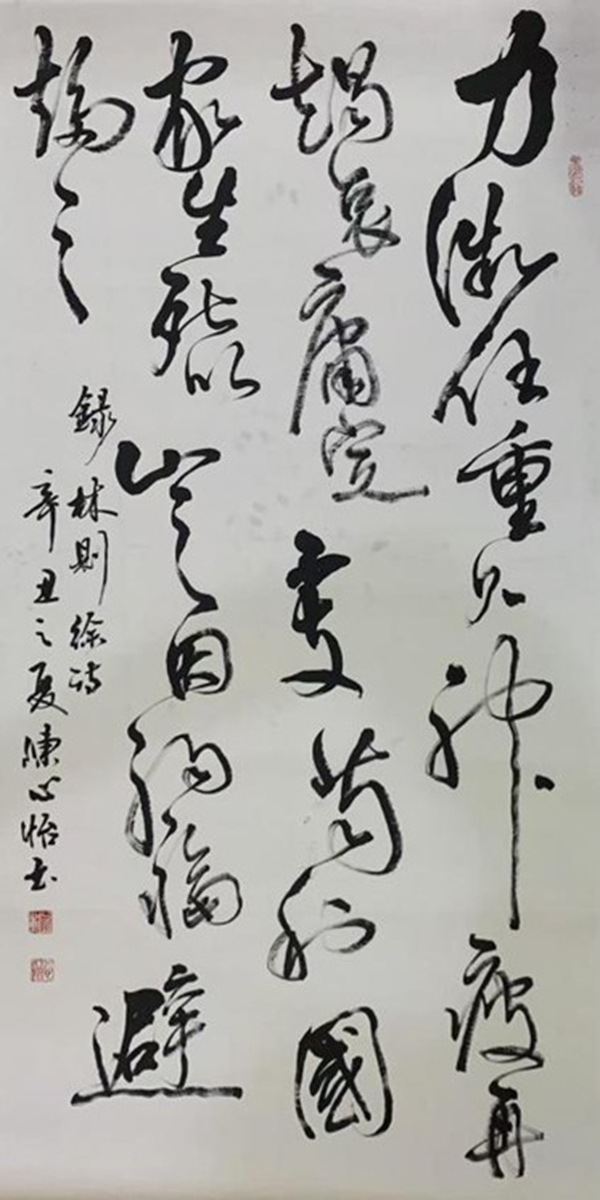
One of Chen's Chinese calligraphy works. [Photo provided to gofujian.com]
Chinese calligraphy, an art form that carries the very essence of millennia-old culture, embodies the infinite beauty of Chinese characters. In recent years, an increasing number of young people from overseas have immersed themselves in the world of brush and ink and Chen Xinyi from Malaysia is one of them.
From curiosity to passion: Journey in calligraphy
Chen Xinyi, 20, is currently studying at Taylor's University in Malaysia. She first encountered calligraphy at the age of seven and its unique texture captivated her deeply. She developed a particular affinity for semi-cursive script, where each stroke captures the perfect balance of strength and the fluidity of the ink. When copying ancient scripts, it felt as though she were conversing with calligraphers from centuries past. "When writing the characters of Wang Xizhi, I could sense the freedom and elegance in his brushwork, almost as though I could understand his emotions," she said.
Recognition through dedication: Awards in calligraphy contests
With a solid foundation and keen insight, Chen Xinyi has excelled in various calligraphy competitions. She's won numerous top awards in events such as the Spring Festival calligraphy competition and the Chaozhou Guild Association arts competition in Malaysia. However, the experience that left the deepest impression on her was participating in the 3rd Overseas Chinese Youth "Impression Fuzhou" competition in Fuzhou, capital of East China's Fujian province. She chose to write Li Mixun's Inscription on the Pavilion of Fuzhou in Spring, aiming to express the essence of the poem and the sublime beauty of Fuzhou's spring through her brushwork.
To perfect her work, Chen spent a lot of time researching Fuzhou, trying to understand the poet’s feelings. "When writing this poem, it felt as though I had truly entered Fuzhou and could see the pavilion," she recalled.
A family legacy: Deep roots in Fujian culture
Chen Xinyi's father hails from Nan'an county-level city in Quanzhou, Fujian, and the family has always upheld strong local Minnan cultural traditions. From gathering together for Spring Festival to offering incense on the birthday of the God of Heaven, the family pays careful attention to every traditional celebration. Her father often shares stories of the customs and folklore of Fujian.
"Fujian, for me, is a sense of cultural belonging," Chen said. She has developed a deep appreciation for the calligraphy styles of Fujian artists, from the vigorous and free-spirited works of Lin Zexu to the strong, enduring strokes of Zheng Chenggong. Each stroke seems to carry with it the resilience and warmth inherent in the people of Fujian.
Chen is also captivated by the architectural heritage of Fujian. "The Hakka tulou building is truly remarkable; its circular structure evokes a sense of both security and warmth. Fuzhou's Sanfang Qixiang embodies the elegance of Jiangnan, while Quanzhou's arcade buildings reflect the inclusiveness of an ancient Maritime Silk Road city," she said.
Promoting calligraphy: Sharing the beauty of art
In Malaysia, an increasing number of young people are beginning to learn Chinese and calligraphy. Chen Xinyi has noticed that many of her peers are now deeply interested in China's development and history – and they hope to reconnect with their cultural roots through the art of calligraphy.
She encourages young participants preparing for the upcoming "Impression Fuzhou" competition to infuse their calligraphy with a genuine understanding of the land. She also suggests learning more about Fuzhou's history, architecture, dialects and folk customs. "Even if you haven't experienced them firsthand," she added, "you can still resonate deeply – through the feelings stirred in your heart."

Copyright © General Office of Fujian Provincial People's Government
Website Identification Code 3500000049Registration Number: 15003084
All rights reserved. The content (including but not limited to text, photo, multimedia information, etc) published in this site belongs to fujian.gov.cn.
Without written authorization from fujian.gov.cn, such content shall not be republished or used in any form.